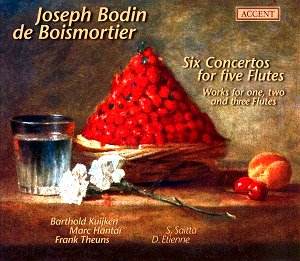Joseph Bodin de Boismortier
was perhaps the very first free-lance
composer in history. Being born in Thionville
in Lorraine as the son of a confectioner,
he went to Perpignan in 1713 and established
himself there as a collector for the
Royal Tobacco Excise Office, a position
he held the next ten years. He must
have received some musical training,
though, since in 1721 a drinking song
by a 'M. Boismortier de Metz' was published.
His musical activities increased and
he went to Paris, where he received
his first permission to publish music
in 1724. He published duos for transverse
flute and cantatas, which was the start
of a career as France's most prolific
composer in the 18th century, whose
oeuvre consists of more than 100 opus
numbers with instrumental music, and
in addition to that cantatas, motets
and some stage works. He also was active
as a theorist, writing treatises on
the transverse flute and the 'pardessus
de viole'.
But Boismortier was
also the victim of sharp criticism.
According to some the size of his musical
output went at the cost of its quality.
He was specifically accused of writing
easy stuff, which could be played by
amateurs with limited technical skills.
The theorist Jean-Benjamin de La Borde
wrote that "Boismortier appeared at
a time when people only liked music
that was simple and very graceful. This
clever musician profited all too much
from this fashionable taste ...". Boismortier
wasn't making any excuses, as de La
Borde writes: "Boismortier, in reply
to these criticisms, said: I make money."
One has to assume, though, that he also
had didactic motifs, as the writing
of the above-mentioned treatises suggests.
And this can be directly linked to the
spirit of the Enlightenment, gaining
ground at Boismortier's time.
Boismortier may have
written a whole lot of music in response
to the growing demand of music which
was not too difficult to play, he was
breaking new grounds in several ways,
and some of his music is very original
in concept. The Concertos for 5 transverse
flutes opus 15, which are recorded here,
are a good example. Never before had
any composer written any music for 5
instruments of the same range without
a bass. And in addition to that, Boismortier
was one of the first French composers
to use the Italian form of 'concerto'.
And indeed there isn't much French in
these concertos. All movements have
Italian titles: allegro, adagio, largo
and affettuoso. Boismortier also abandoned
any prescription of the ornamentation
which was so characteristic for French
music. The title of 'concerto' suggests
a contrast between 'soli' and 'tutti',
and that is indeed the distinctive feature
of these concertos. The five transverse
flutes are not treated as equals: in
most concertos one or two play the leading
role, whereas the others play the 'tutti'.
And although the concertos don't have
a part for basso continuo, one of the
flutes is in fact acting like a bass.
One could compare these concertos with
the 'concerti da camera' by Vivaldi.
It isn't in the concertos
for five flutes only that the parts
are treated differently. Even in the
Sonata for two flutes from opus 38 the
two flutes are no equals: the first
flute is dominating, although both instruments
are in dialogue in some passages.
The sonata for flute
solo which opens this disc is one of
the most typically French pieces of
the programme: it starts with a 'prélude',
like so many suites by French composers,
and this is followed by four dance movements.
This sonata can be played with or without
basso continuo. Also French in style
is the Sonata for three transverse flutes
from opus 7, in four movements with
French titles. Sometimes the three flutes
imitate each other, in other instances
they follow their own route.
This disc shows Boismortier
at his best. All pieces on the programme
are delightful and entertaining, and
they get the best possible performance
here. The ensemble playing is immaculate,
and the sound is delicate and refined.
The tempi are well chosen, and phrasing
and articulation are clear. Of course,
the dynamic differentiation is very
important in these concertos, and this
is dealt with very convincingly. I especially
enjoyed the Concerto no. 3, which is
one of the most Vivaldian, and whose
fast movements are played with great
panache. And Barthold Kuijken gives
a very sensitive performance of the
solo sonata.
The above-mentioned
theorist Jean-Benjamin de La Borde,
in spite of his criticism, acknowledged
that one may find some grains of gold
in the mine of Boismortier's oeuvre.
This disc presents nine of them in sparkling
performances.
Johan van Veen







